The AMD Trinity Review (A10-4600M): A New Hope
by Jarred Walton on May 15, 2012 12:00 AM ESTAMD Trinity General Performance
Starting as usual with our general performance assessment, we’ve got several Futuremark benchmarks along with Cinebench and x264 HD encoding. The latter two focus specifically on stressing the CPU while PCMarks will cover most areas of system performance (including a large emphasis on storage) and 3DMarks will give us a hint at graphics performance. First up, PCMark 7 and Vantage:
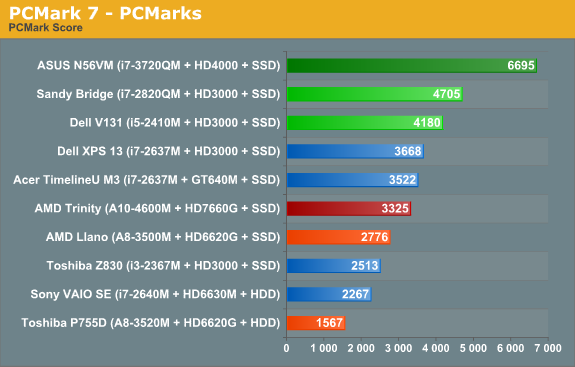
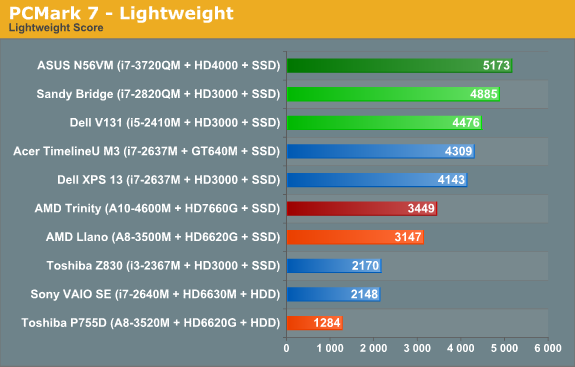
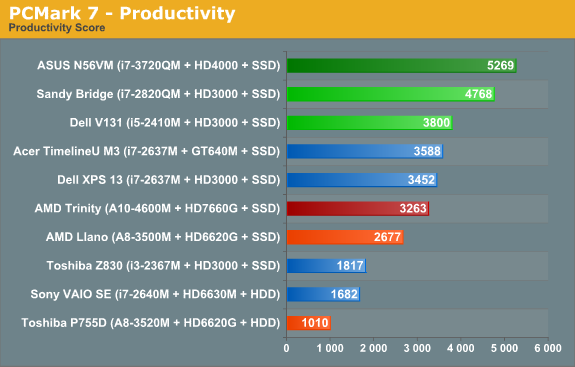

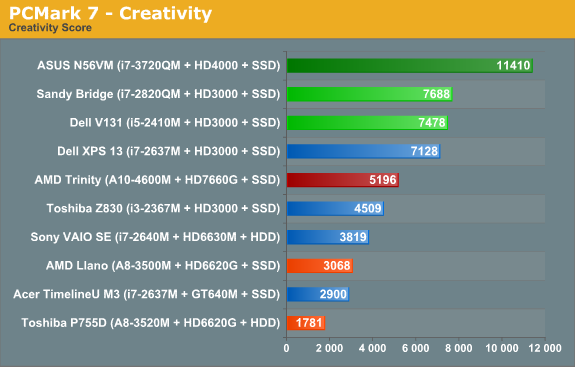
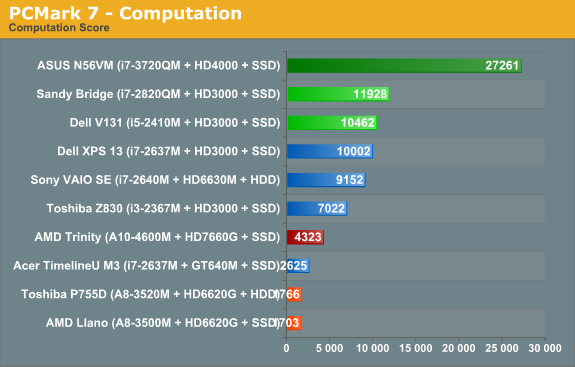
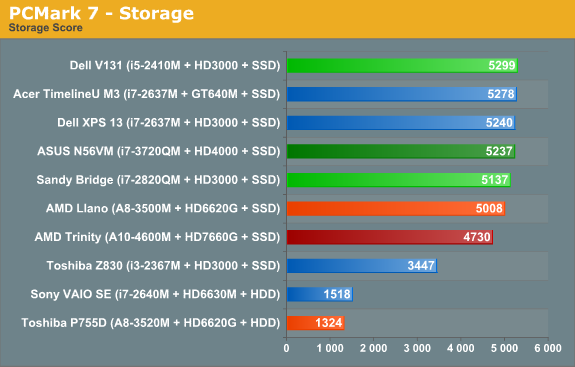
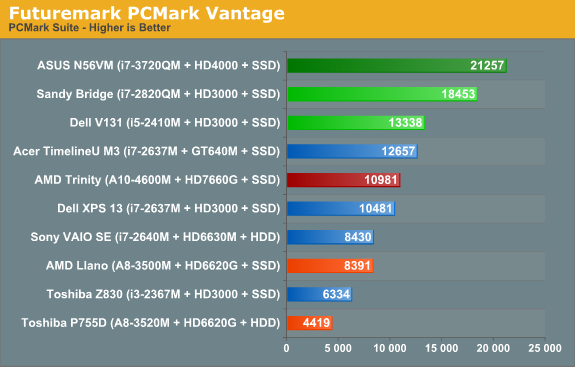
As noted earlier, we ran several other laptops through PCMark 7 and PCMark Vantage testing using the same Intel 520 240GB SSD, plus all the ultrabooks come with SSDs. That removes the SSD as a factor from most of the PCMark comparisons, leaving the rest of the platform to sink or swim on its own. And just how does AMD Trinity do here? Honestly, it’s not too bad, despite positioning within the charts.
Obviously, Intel’s quad-core Ivy Bridge is a beast when it comes to performance, but it’s a 45W beast that costs over $300 just for the CPU. We’ll have to wait for dual-core Ivy Bridge to see exactly how Intel’s latest stacks up against AMD, but if you remember the Llano vs. Sandy Bridge comparisons it looks like we’re in for more of the same. Intel continues to offer superior CPU performance, and even their Sandy Bridge ULV processors can often surpass Llano and Trinity. In the overall PCMark 7 metric, Trinity ends up being 20% faster than a Llano A8-3500M laptop, while Intel’s midrange i5-2410M posts a similar 25% lead on Trinity. Outside of the SSD, we’d expect Trinity and the Vostro V131 to both sell for around $600 as equipped.
A 25% lead for Intel is pretty big, but what you don’t necessarily get from the charts is that for many users, it just doesn’t matter. I know plenty of people using older Core 2 Duo (and even a few Core Duo!) laptops, and for general office tasks and Internet surfing they’re fine. Llano was already faster in general use than Core 2 Duo and Athlon X2 class hardware, and it delivered great battery life. Trinity boosts performance and [spoiler alert!] battery life, so it’s a net win. If you’re looking for a mobile workstation or something to do some hardcore gaming, Trinity won’t cut it—you’d want a quad-core Intel CPU for the former, and something with a discrete GPU for the latter—but for everything else, we’re in the very broad category known as “good enough”.


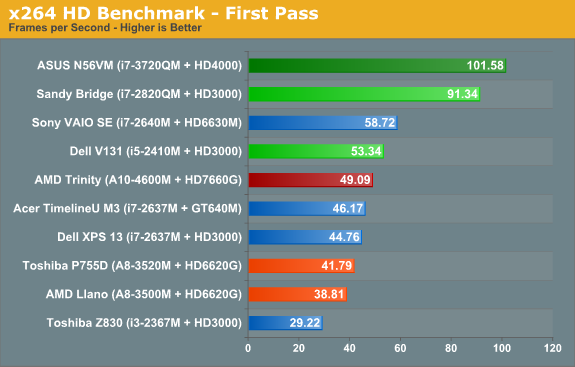
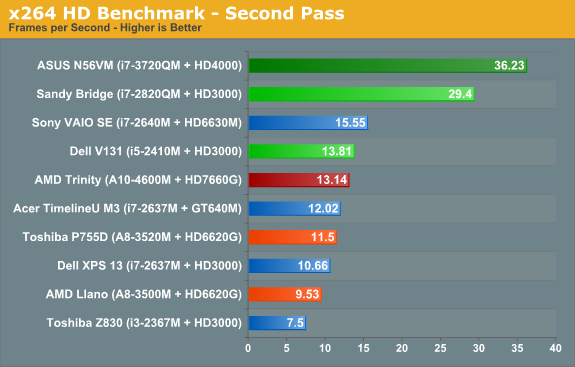
When we start drilling down into other performance metrics, AMD’s CPU performance deficiency becomes pretty obvious. The Cinebench single-threaded score is up 15% from 35W Llano, but in a bit of a surprise the multi-threaded score is basically a wash. Turn to the x264 HD encoding test however and Trinity once again shows a decent 15% improvement over Llano. Against Sandy Bridge and Ivy Bridge, though? AMD’s Trinity doesn’t stand a chance: i5-2410M is 50% faster in single-threaded Cinebench, 27% faster in multi-threaded, and 5-10% faster in x264. It’s a good thing 99.99% of laptop users never actually run applications like Cinebench for “real work”, but if you want to do video encoding a 10% increase can be very noticeable.

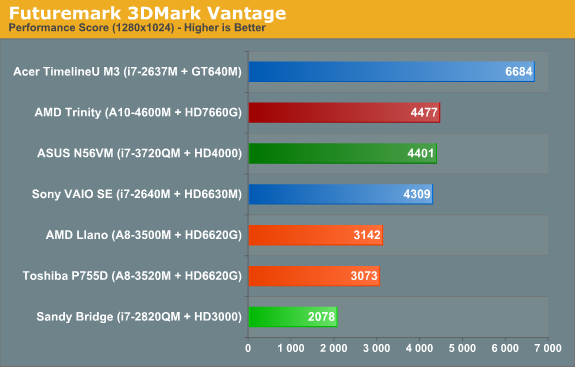
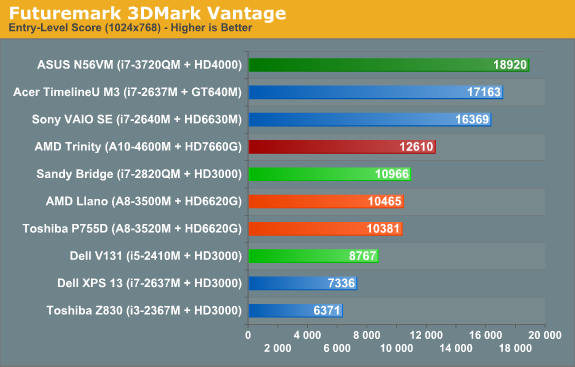
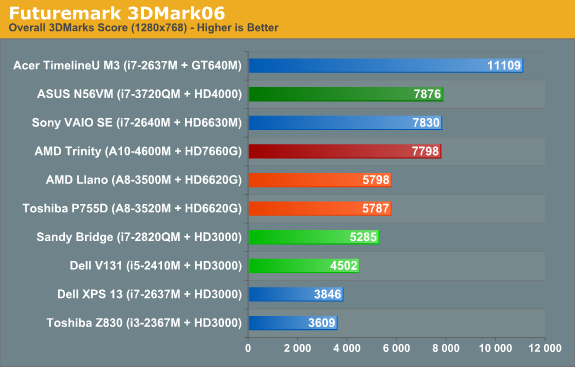
Shift over to graphics oriented benchmarks and the tables turn once again...sort of. Sandy Bridge can’t run 3DMark11, since it only has a DX10 class GPU, but in Vantage Performance and 3DMark06 Trinity is more than twice as fast as HD 3000. Of course, Ivy Bridge’s HD 4000 is the new Intel IGP Sheriff around these parts, and interestingly we see Trinity and i7-3720QM basically tied in these two synthetics. (We’ll just ignore 3DMark Vantage’s Entry benchmark, as it’s so light on graphics quality that we’ve found it doesn’t really stress most GPUs much—even low-end GPUs like HD 3000 score quite well.) We’ll dig into graphics performance more with our gaming benchmarks next.










271 Comments
View All Comments
Kaggy - Tuesday, May 15, 2012 - link
And at lower power consumption.Pantsu - Tuesday, May 15, 2012 - link
Unfortunately for AMD, the processor is only a small part of the laptop BOM. Even if Trinity is cheaper, the difference in the end product is not that big. Still, the mainstream 15" cheapo laptop is perhaps the last refuge AMD has.Looks like Trinity is still the way to go for low end gaming, but it's disconcerting to see HD4000 actually beat it in few tests. AMD really needs to get a better CPU architecture going.
HSA is still long ways to go too, and I just don't see AMD pulling off the necessary developer support for it to really work, unless Intel goes along the same lines, in which case they might as well just give up.
iwod - Tuesday, May 15, 2012 - link
I am guessing Haswell will have some CPU improvement with FMA, New AVX, etc... and 3 times faster Graphics..... I dont see Trinity or what ever behind it having too much hope.I am also wondering if Intel could further improve those games performance with better drivers. Again Intel may have caught up with the hardware department ( The easier part ), their drivers are still lacking behind.
Spunjji - Tuesday, May 15, 2012 - link
I'd like to think that an AMD CPU with their current GCN graphics on a 28nm-or-smaller process would at least be GPU competitive with Intel. We live in interesting, times, though.duploxxx - Tuesday, May 15, 2012 - link
you can always believe marketing that they will be able to perform that kind of GPU leap while in the past they have always struggled to enhance. Sure the 4000 is already getting better (near Liano perf) it only shines in the few synthetical benchmarks and where the AMD is limited to CPU performance.perhaps try a few higher res games and see how much is left from the Intel GPU...
AMD is limited to memory bandwidth, Intel will suffer from the same.
cyrusfox - Tuesday, May 15, 2012 - link
So when will I be able to find a good trinity laptop with backlit keyboard in a small 13" form factor or preferably smaller. I would like to upgrade from brazos, and brazos 2.0 isn't going to hack it.JarredWalton - Tuesday, May 15, 2012 - link
This is the hard part: just about every OEM that makes an AMD laptop ends up targeting the budget market, and in that market they cut every corner possible. Forget quality LCDs (which would add around $10 to the BoM for most laptops), forget better build materials, and forget amenities like backlit keyboards. Oh, I'm sure someone will make a Trinity laptop with a backlit keyboard, but then they'll probably ask $800 for it. HP has their Envy 14 coming in "Sleekbook" trim that might get you a backlit keyboard, though--and it's price starts at $700.FrontBoard - Tuesday, May 15, 2012 - link
Trinity is the name of a river in Texas, just as Comal and Brazos are. That is likely where the codenames come from.kevith - Tuesday, May 15, 2012 - link
Thanks!JarredWalton - Tuesday, May 15, 2012 - link
For the record, I *did* know that AMD is grabbing names of rivers. I guess it could be better stated: "I wonder if AMD was trying to have a secondary meaning with their codename." And it was a nice hook for the conclusion. :-)